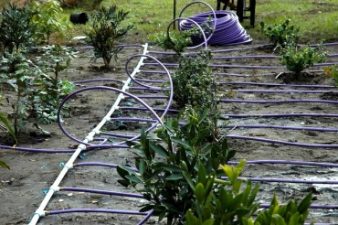 Islamic architects piped sunlight into homes using star-shaped skylights but Brian and his wife installed Solotubes.
Islamic architects piped sunlight into homes using star-shaped skylights but Brian and his wife installed Solotubes.
One of the first changes my wife and I made to our house was to install a Solotube in the kitchen. This device consists of a translucent dome on the roof which is connected to a highly silvered six foot long pipe through the attic. The bottom end of the pipe spills sunlight into the kitchen even during the dullest winter days. But we have discovered that the idea isn’t new. Islamic architects have been using a variation of the technique for hundreds of years.
[youtube http://www.youtube.com/watch?v=buMyJPQLS9U]
The modern variation of solo tubes in the Phillipines
I shouldn’t be surprised that this idea predates the 1990s. In fact, we found something very similar in the Islamic architecture in Granada and Istanbul. A star-shaped skylight would be deeply set into white-washed walls and angled such that the summer sun would bring a glow into the room without the intense heat of direct sunlight.
The skylights in the 14th century Los Baños del Almirante in Valencia Spain (above) are an example of this Moorish inspired design. I.M. Pei’s atrium skylight in Qatar’s museum of Islamic art is a modern variation on this technique.
My architect friends must be laughing at me for being impressed by something this simple but I only have to compare it with my workplace. It’s a two story office building with an atrium that was built in the late 1990s, but no one seems to know how regulate heat and light here in Ireland – even though the country has such a mild climate.
Boneheaded designs
During a few days around the Winter Solstice, sunlight slips between two buildings and bounces off a pond onto my desk. I would be impressed if I wasn’t convinced that this is a complete coincidence. A few miles away there are some ancient burial tombs which are intentionally aligned with the solstice sun.
Newgrange is about 5,000 years old and has the equivalent of a Solotube aligned with the winter solstice sun. Why do we seldom see such examples of celestial alignments and optics being used in modern architecture? I suppose it’s because oil is so cheap and therefore air-conditioning, lights and heating compensate for boneheaded designs.
Our Solotube kept the cold rain out and brightened up our dreary kitchen for about $500. The fiber optic version can pipe sunlight longer distances but it is much more expensive at $8000. The skylights in the mosques, hammans and the Qatar museum are also expensive.
But a group of students from Massachusetts Institute of Technology (MIT) recently came up with a much less expensive way to pipe sunlight into the interiors of shanties in the slums of Manila Philippines using plastic bottles filled with water.
Flickr photo of Baños del Almirante in Valencia by Chosovi
More on Islamic Architecture:
Gaza’s Green Schools Fuse Islamic Architecture and Sustainable Design
13 Principles of Sustainable Architecture From Nader Khalili Student
Hassan Fathy is the Middle East’s Father of Sustainable Architecture




I’m glad to hear that Laurie. It does look like an idea which would work in lots of other places.
Amanda’s club might want to try this. Fill a bottle with water and add a couple of drops of milk so you can see light beams. Shine a bright LED light from the top and you can see how it is reflected down the walls by refraction and total internal reflection at the water/plastic/air interface.
http://tinyurl.com/7ywv8vu
One rule of thumb I heard long ago was that the angle a between a solar panel and the ground should be your latitude + 10 degrees (I think the + 10 degrees was to keep the snow off!) The top of a Pepsi bottle on a flat roof is just about right for Manila.
Amanda’s school enviro-club will eat this up. I’ll also pass it around to friends doing work in refugee housing. Thanks for the link, hope it gets this gent some serious support.
That’s a great question. I haven’t found any micro-financing schemes directly associated with Isang Litrong Liwanag’s project but I should have linked directly to his, “Liter of Light” website where he has information on donations and instructions for making your own Solar Bottle Bulb. Here is the link: http://isanglitrongliwanag.org/
Brian – the solar bottle clip is brilliant! (I could’ve used some in the shack on Inbhir Ide.) Any clue if micro-financing schemes are available to inventors like the man in your feature?